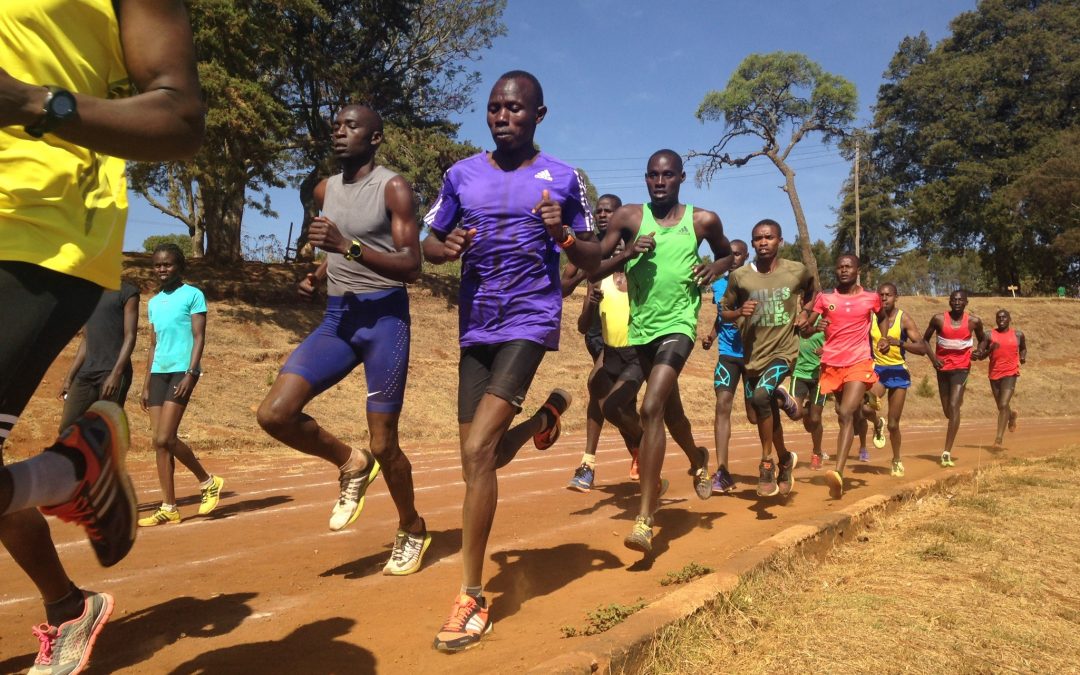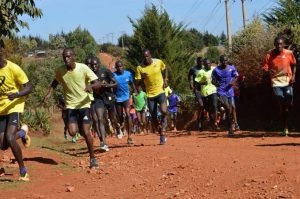Kenyan Training Observation & Discussion: Is it better to run a workout at your own pace ensuring you complete the full session or to run at your desired pace and simply hold on for as long as you can, even if that means you do not complete the workout?
When we posted the fartlek video on Facebook on Tuesday it got me thinking about another aspect of Kenyan running which is rarely, if ever discussed.
We mentioned within the video description that Kenyan runners all start together and then run the same session or a portion of the same session. And that point right there is what we want to discuss today.
In Kenya, the normal method is to run with the leaders for as long as you can. When you are no longer able to keep up you stop, most Kenyan training groups see the majority of runners drop out before the training session is complete.
This is in contrast to the typical methods where by each runner completes the full session at their own given pace. With Kenyan athletes, you will see huge groups starting out on the track, for fartlek, for long runs etc and by the end of the session only the best runners remain.
For example, in a track session of 12x1000m you might see a group of 30 athletes starting out, all running around 2:50. By the 4th or 5th interval some of the weaker runners have started to drop out, by rep 8 the initial 30 is now 10 and the final 2-3 reps are completed only by the strongest couple of runners in that group.
If you think about big city marathons which you have watched on TV we see the same pattern. More so in the tier 2 and 3 races which often have deeper fields with more African runners but less star names.
At the half way point we see a group 15-20 runners on or close to world record pace, the commentators start to get excited but gradually over the course of the next 10-15km the 20strong group diminishes to 5 and by the finish line we see the 10th place athlete 4-5 minutes behind the winner even though there was a group of 20 together at half way.
Although I had seen this on the track in Iten, I think the first time I really noticed it as something significant was when I was coaching with Renato Canova and our group had a long run during the specific marathon phase. The ‘Group’ was really very small made up of Abel Kirui, Jonathan Maiyo and a few other select athletes marathoners. We did however, have in tow a plethora of other aspiring athletes, some of whom were designated pacemakers but the majority were just other local runners wanting to impress Renato or just get in a good workout with his group.
As is the way for top marathon runners in Iten we had driven out to Nangili, about 75-80minutes from Iten for this long run – 40km was on the cards today. We had a couple of minibuses to follow the athletes for coaching purposes, hand out drinks, collect the stragglers etc.
About 20minutes in to the 40km run (averaging around 3’20”/km pace) the first athlete pulled to the side of the road and indicated he was done and wanted to get in the bus. I didn’t know who he was but I thought to myself ‘wow – this guy is going to be pissed off! He’s woken up at 4am to drive out to Nangili for a 6am start now he has to sit in the van for the next 2 hours watching the others run, before we then make the long journey home.
To my amazement, he was far from angry or despondent. A beaming smile as he climbed into the van “wow – that was very nice” He said to no one in particular. I turned around and asked him “You only ran 20minutes – is that good?” He replied “Yes, very good. Today I run 20minutes with these guys (Meaning Abel and Jonathan), next week 30 or even 40. Very soon I am running the whole way with these strong guys”
I’ve no idea if that ever proved to be the case, but it is a good example of this common pattern seen with Kenyan runners. In most other running cultures, the idea would be to run the full volume at a pace which you could sustain and thus ensure that you complete the full workout. Kenyan’s are not really interested in that and would far prefer to run at the pace they think is ‘correct’ or ‘better’ even if it means that they do not run even half of the full session.
This may also explain why the drop out rate in races in Kenya is so high. Anyone who has watched a race in Kenya will be able to attest to the fact that many many runners DNF, sometimes in the early stages of the race. Most of the athletes go off at a pace either with the leaders, or with other runners they aspire to be as good as, or think that they are in the same calibre as, and when they can no longer sustain that pace they simply step aside.
I’m not really suggesting that one method is favourable to the other, rather highlighting an interesting difference. The Kenyan method is, however, vaguely in line with one of Coach Renato Canova’s most fundamental principles of endurance training. That is, the principle of Extension of Endurance. That deserves a blog of it’s own sometime, but in summary Renato trains runners to hold a given pace for progressively longer periods of time. Essentially the idea is that all runners can already run their target pace for their goal race. So speed is not the challenge – the challenge is to hold that speed for the entire duration of the race. Renato starts by breaking that down into smaller manageable chunks, and as the target race approaches the chunks get longer but stay at the same pace. This is as apposed to starting with the same final workout but at a slower pace and then trying to run a little faster each time you return to that workout.
For example: Imagine a runner wanting to run 40:00 for 10km. The Extension of Endurance approach might have a progression of workouts as follows:
1) 20x500m in 2:00 (rec 60”)
2) 12x800m in 3:12 (rec 60”)
3) 10x1000m in 4:00 (rec 60”)
4) 5x2000m in 8:00 (rec 60)
3) 3x3000m in 12:00 (rec 60”)
These are of course only for illustrative purposes, there may be other progressions between any of these or certain levels may need to be repeated before moving on. But the idea is there – you run at the correct pace, and then extend your ability to run at that pace. This is as apposed to a more common approach where you might run 10x1000m 4 or 5 times – starting at 4:10-15″ and gradually trying to work down a little faster each time.
I think that Renato’s approach is somewhat similar to the approach that so many Kenyan’s seem to have as their natural tendency. They want to run at what they see as the correct pace and then try to hold that for a little longer each time.
I suspect that if any of these athletes were working directly with Renato he would advise them not to step off the track altogether at the point they currently do, but to reduce the volume of each interval at that point from say 1000’s to 500’s and to continue to finish the full volume of the workout as well as at the correct pace. Then, in time, they can make that 500 a 600, a 700 etc etc until they are able to complete the full session at their desired speed. Or to mix between the 2 systems – one week like this, next week cover the full distance at your own pace.
There is clearly an element of overlap in both ways of thinking and I believe it is an idea that other runners can consider as well. If you are at your club night and there is one runner who is always a little way ahead of you throughout the session, consider running with them and see how long you can keep up. Maybe you make 60% of the workout before you have to relent. Next time go back to your own pace and complete the full distance, then on the 3rd week go back to running with the faster club mate and see if this time you are strong enough to stay with them for 65-70% of the workout.
By taking a leaf out of the Kenyan’s book you may just surprise yourself.
Thanks for reading,
Gavin



Recent Comments